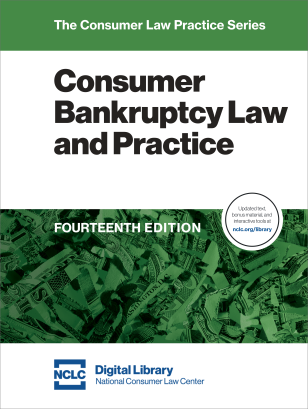Important Bankruptcy Rules governing chapter 13 practice took effect on December 1, 2017. These rule changes affect the form of chapter 13 plan used in every district, procedures for valuing and voiding liens, filing deadlines for creditor proofs of claim, objections to proofs of claims, and objections to plan confirmation. Far more detail on the new rules is found in the digital version of NCLC’s
Consumer Bankruptcy Law and Practice. This article links to the updated sections of the treatise, the new rules, and new
Official Form 113.
Form of Chapter 13 Plan
The form of the chapter 13 plan is now prescribed by Bankruptcy Rule 3015(c). It requires that a new national form plan,
Official Form 113, be used unless the judicial district where the case is filed has adopted a local form plan that complies with
Rule 3015.1. Most districts have opted out of using the national form plan, though many of the approved local form plans have provisions similar to Official Form 113. Practitioners should check their local court’s website to determine whether the national or a local form plan is required, and to review any related local rule. These changes are analyzed in detail in NCLC’s
Consumer Bankruptcy Law and Practice § 7.3.12.2.
Both the national and local forms provide a section where the debtor may include “nonstandard provisions,” which are defined in
Rule 3015(c) as provisions “not otherwise included in the Official or Local Form or deviating from it.” To be given effect, these provisions must be included in that section of the plan and highlighted by a notice at the beginning of the plan.
Procedure for Valuing Secured Claims
In addition to filing a motion or claim objection,
Bankruptcy Rule 3012(b) now permits the debtor to request a determination of the amount of an allowed secured claim through a chapter 13 plan provision, except for claims of governmental units (which may be made only by motion or claim objection). If the plan is used, it must be served in the manner provided for service of a complaint and summons under Bankruptcy Rule 7004, which in most cases means first class mail.
Rule 3015(g)(1) is also amended to provide that any determination of the secured claim amount made through confirmation of a chapter 13 plan is binding on the creditor, even if the creditor files a proof of claim in a different amount and no objection to the claim is filed. These changes are discussed in NCLC’s
Consumer Bankruptcy Law and Practice §§ 11.2.2.1 and
12.11.
Procedure for Voiding Liens
Under former Bankruptcy Rule 4003(d), lien avoidance under 11 U.S.C. § 522(f) was done exclusively by the filing of a motion. The rule now permits lien avoidance to be initiated through a plan provision.
Rule 4003(d) is amended to provide that a lien may be avoided by filing either a motion or by serving a chapter 13 plan on the lien holder in the manner provided for in Rule 7004. New
Rule 5009(d) also provides a procedure for obtaining an order declaring that the lien is released under the terms of a confirmed plan.
See NCLC’s
Consumer Bankruptcy Law and Practice § 10.4.2.2.
Surrender of Collateral
Although not required by the Code,
Bankruptcy Rule 3015.1(d)(4) mandates that any local form plan must contain a provision for surrendering secured property, which must also be accompanied by a request that the automatic stay be terminated under Code sections 362(a) and 1301(a) as to the surrendered collateral. A similar provision is included in the national form plan,
Official Form 113.
Rule 3015(g)(2) provides that any request in the plan to terminate the stay is granted when the plan is confirmed. If the debtor provides for surrender of collateral in the plan and is nevertheless pursuing a loan modification or some other form of loss mitigation with the secured creditor, the debtor may wish to include in the nonstandard provision section of the plan a request that the court maintain the stay notwithstanding the surrender provision.
See NCLC’s
Consumer Bankruptcy Law and Practice § 7.3.12.3.
Service of the Plan
If the plan is not included with the notice of the confirmation hearing that is mailed by the clerk’s office,
Bankruptcy Rule 3015(d) requires the debtor to serve the plan on the trustee and all creditors when it is filed with the court. If the plan contains a request that property be valued to determine an allowed secured claim under Rule 3012(b) or a request for avoidance of a lien under Rule 4003(d), it must be served under the procedures in
Rule 7004. Service under Rule 7004 ordinarily is done by first class mail, except that insured depository institutions must be served pursuant to Rule 7004(h) by certified mail addressed to an officer of the institution. If these requests are made in the plan, the debtor must also highlight this in an initial paragraph of the plan, usually by checking an applicable box.
See NCLC’s
Consumer Bankruptcy Law and Practice § 7.3.12.2.
Notice of Plan Confirmation and Objections
The bankruptcy clerk is required to give at least twenty-eight days’ notice of the date of the confirmation hearing in a chapter 13 case under amended
Rule 2002(b)(3), and at least twenty-one days’ notice of the time for filing objections to confirmation under amended
Rule 2002(a)(9).
Bankruptcy Rule 3015(f) provides that objections to plan confirmation must be filed and served upon the debtor and the trustee, as well as transmitted to the United States trustee, at least seven days prior to the date set for the confirmation hearing, unless the court orders otherwise. The former rule simply stated that objections were to be filed before confirmation of the plan.
See NCLC’s
Consumer Bankruptcy Law and Practice § 8.6.
Bar Date for Filing Claims
Creditors must timely file a proof of claim in order to have an allowed claim. Amendments to
Rule 3002(c) now give most creditors less time to file a claim. The time deadline for filing claims in chapter 7 (voluntary), 12, and 13 cases is now seventy days from the date the petition is filed or, if the case is converted to chapter 12 or 13, the date of conversion. Claims by governmental units may be filed until 180 days after the order for relief. Prior to the 2017 amendments, the rule had set the time in all chapter 7, 12, and 13 cases at ninety days after the first date set for the section 341 meeting of creditors.
Courts may grant an extension of the filing deadline based on a motion filed under amended
Rule 3002(c)(6)(A), if the creditor did not receive notice in time to file a timely proof of claim because the debtor failed to timely file the list of creditors’ names and addresses required by Rule 1007(a). If the court grants such a motion for extension, the extension may be no more than sixty days from the date of the order granting the motion.
Holders of claims secured by a security interest in the debtor’s principal residence are given additional time to file supplemental attachments to the proof of claim.
Rule 3002(c)(7)(B) provides that any attachments required by Rule 3001(c)(1) and (d), such as a copy of the mortgage or deed of trust and evidence that the security interest is perfected, must be filed as a supplement to the holder’s claim not later than 120 days after the petition date.
Prior to the 2017 amendments, the rules did not expressly require secured creditors to file claims.
Rule 3002(a) was amended to clarify that all creditors, including secured creditors, must file a proof of claim in order to have an allowed claim.
These changes are discussed in NCLC’s
Consumer Bankruptcy Law and Practice §§ 11.6.2.8.2.2 and
14.4.3.2.
Objections to Claims of Creditors
Amended Bankruptcy Rule 3007(a)(1) provides that an objection to a proof of claim and a notice of objection must be filed with the court and served at least thirty days prior to any scheduled hearing on the objection or any deadline for the claimant to request a hearing. The objection and notice must be served by first-class mail on the person designated on the original or amended proof of claim to receive notices, at the address listed for receipt of notices (except that the notice and objection must be served in accordance Rule 7004(b)(4) or (5) if the claimant is the United States and in accordance with Rule 7004(h) if the claimant is an insured depository institution). Local courts may require claimants to request a hearing or file a response to the objection before a hearing will be scheduled or held on the objection.
See NCLC’s
Consumer Bankruptcy Law and Practice § 8.3.9.


